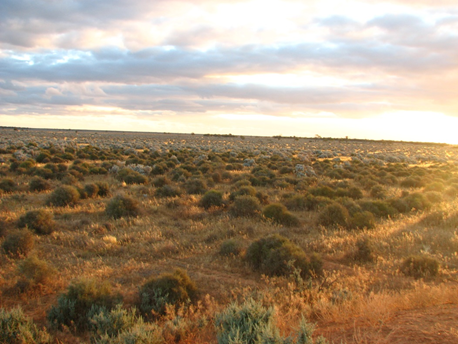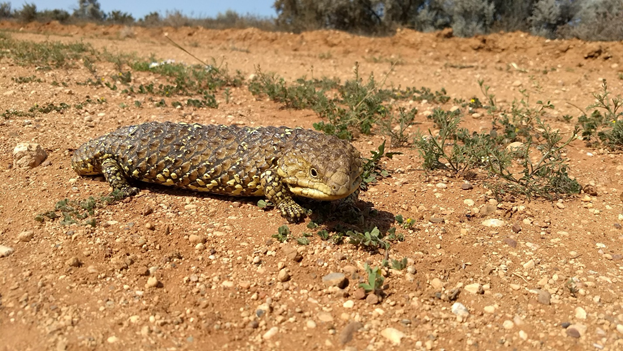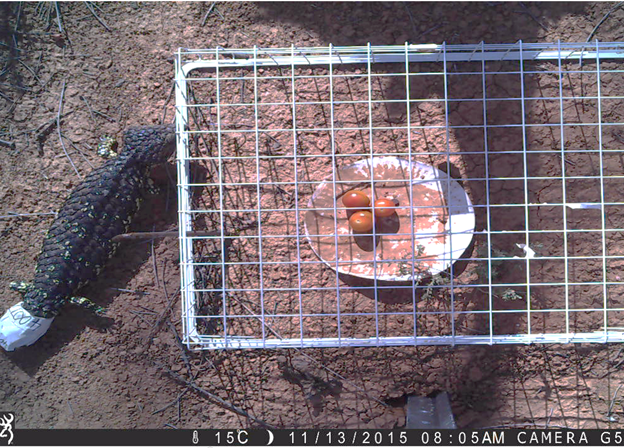This blog post is provided by Orr Spiegel and Marcus Michelangeli and tells the #StoryBehindthePaper for the paper “Resource manipulation reveals interactive phenotype-dependent foraging in free-ranging lizards”, which was recently published in the Journal of Animal Ecology. Using bananas and tomatoes, the authors explore how the foraging behaviour of sleepy lizards in South Australia is affected by their boldness and aggressiveness behavioural type.
It was going to be another long and hot day in ‘the frypan’ of the ‘Australian bush’. We are at our field site, Bundey Bore, a few hours north of Adelaide, South Australia (Figure 1). First task of the day is to set up our behavioural assays early before the sleepy lizards become active, and a survey of the tomato experiment was also awaiting. The short ride along the dirt road from our homestay (a rusty farm) went smoothly, with Emus and Red kangaroos hopping away as we approached, and the first rays of sun colouring the vast plains in soft colours before the bleaching light and heat of mid-day.

While some of us were preparing the arenas and equipment for the behavioural assays, others took the bio-telemetry gear and set out to locate the chosen lizards of the day. We have been studying this population of sleepy lizards for several years, so for many individuals in the population we have multiple years of biometric, behavioural and movement data. Initially, finding a ‘fresh’ lizard for the season is always a challenge (Figure 2), they have superb camouflage, and they readily hide in the brown leaf-litter or under a thorny shrub when they hear us approaching. But once caught and processed we release them with both a GPS tag (for tracking their movements), and a radio-tag for locating them routinely for data download and inspection. Typically, finding the daily candidates via radio tracking goes smoothly, but today one lizard had decided to go on a long adventure – eventually we located it sleeping under a massive dead black oak (Casuarina) tree.

To measure a lizard’s behavioural type, we conduct two behavioural assays. First, we measure an individual’s boldness by observing how willing an individual is to approach a banana in the face of an apparent risk – the observer. Second, we measure an individual’s aggressiveness by observing how it responds to an attack by a model of a conspecific. We found that lizards are remarkably consistent in their response to the two assays, even across multiple years. The two behaviours are also independent meaning that some lizards are consistently bold and aggressive, some are always shy and docile, but then others consistently express a ‘mismatched’ combination of these two behavioural types (e.g., aggressive and shy). Once the behavioural assays were completed, we released lizards back at their capture location – left alone, until it was time for another visit in two weeks to collect more data on each individual.
On ‘the menu’ for the rest of the day was cherry tomato replenishing. We were running an experiment of artificial food supplementation, maintaining a grid of 123 food patches distributed evenly across our study site. Food patches contained either 9, 3 or zero cherry tomatoes – representing high food quality, low food quality and control food patches, respectively. Camera traps which filmed visiting lizards in some of the patches, allowed us to quantify their foraging behaviour at the patch (Figure 3). Twice a week we would visit each food patch, document how many tomatoes were consumed, recharge cameras, and replace all consumed or dried tomatoes with fresh ones. The cherry tomatoes proved to be an amazing resource for our experiment: not only are they very conspicuous, but the lizards also love them because of their high water density – a rare resource in an extremely dry environment. Cherry tomatoes were also the perfect size for a lizard’s gape and minimized unwanted foragers like ants and other insects – we found that other fruits would become infested within minutes! Lizards were really attracted to the tomatoes and would occasionally consume them merely a few minutes after we deployed them (Figure 3).
The aim of this experiment was to determine how a lizard’s behavioural type, as well as social and environmental factors, shaped its foraging behaviour. By combining several complementary datasets, the system offered us a unique opportunity to go deep into the interactive effects of animal personality, movement ecology and foraging ecology. As we had GPS tracked each focal lizard for the majority of its active season, we could comprehensively quantify their home range size, and determine how many food patches they likely had access to. Tracking many individuals in the same population also allowed us to investigate how social feedbacks affected an individual foraging behaviour. We also had survey data on local habitat features surrounding food patches, and photos of actual visits. This incredibly unique dataset allowed us to dissect the foraging process into specific steps – from food search to handling – and determine how individual, social, and environmental factors influenced an individual’s overall foraging performance (e.g., how many tomatoes they ate per visit or throughout the experiment).

Data processing, analysis, and modelling this comprehensive dataset was a challenging task. It took a while to develop the analytical framework and establish how exactly each of the different factors affected a specific phase of the foraging process. Regarding behavioural types, what we found was largely an interactive pattern: more aggressive lizards were less attentive to the quality of the food patch and would return to high and low food patches equally, whereas other lizards (e.g. unaggressive individuals) would preferentially revisit high quality food patches. Bolder lizards visited patches more regularly than shy ones, and would eat a higher proportion of available tomatoes when visiting a food patch. Lizards that were both bold and aggressive ate the highest quantities, followed by shy and non-aggressive lizards, whereas lizards that were both aggressive and shy ate fewer tomatoes overall. But all these insights, and hopefully more to come, were still in the far future at that day. As the sun was settling to the west, after a long day in the field, we finally turned back to the farm, leaving behind sleepy lizard land. This incredible study system has revealed to us many ecological wonders, offering a glimpse into how life persists in this challenging environment, and some key insights regarding the power of field experiments for studying free-ranging animals. And the remaining unused cherry tomatoes were to become part of a nice Chili dinner over the weekend…
Read the paper
Read the full paper here: Spiegel, O., Michelangeli, M., Sinn, D. L., Payne, E., Klein, J.-R., Kirkpatrick, J., Harbusch, M., & Sih, A. (2024). Resource manipulation reveals interactive phenotype-dependent foraging in free-ranging lizards. Journal of Animal Ecology, 00, 1–15. https://doi.org/10.1111/1365-2656.14128
